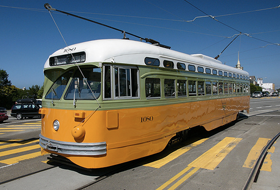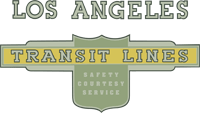This car is painted in the livery of Los Angeles Transit Lines (LATL), which operated PCC streetcars after World War II.
Los Angeles Railway (whose 1937 PCC livery is worn by Muni No. 1052) sold out in 1945 to National City Lines (NCL), which was owned by oil, tire, and bus companies. NCL was infamous for buying up streetcar lines and converting them to buses, to the profit of its owners (who were convicted of federal conspiracy charges in 1949).
However, NCL didn’t follow its normal script in LA. Operating as Los Angeles Transit Lines, NCL actually bought more streetcars, 40 extra-wide PCCs of No. 1080’s body style in 1948, to modernize the P-Pico line, where patronage was too heavy for buses. Some other streetcar lines also survived, possibly because of the superb maintenance of the streetcars, track, and overhead wire, which Los Angeles Railway had kept up, even as other systems around the country fell into disrepair.
 Steve Ferrario photo.
Steve Ferrario photo.The new Pico line streetcars were painted in the standard NCL paint scheme modeled on this car. NCL streetcars in other cities, such as El Paso, wore nearly identical liveries (Muni’s No. 1073 wears a later El Paso livery). If the East Bay’s Key System had gone ahead with a potential PCC purchase, you would have seen this livery in Oakland, too.
Massive freeway construction in the 1950s and the resulting suburban sprawl stole riders from both LATL and its interurban counterpart Pacific Electric. Six major LATL streetcar lines were converted to buses in 1955. This allowed PCCs to take over from the last of the company’s conventional streetcars on such lines as the crosstown V-Vermont-Vernon and the S-San Pedro-West Eighth Street.
In 1958, publicly owned Los Angeles Metropolitan Transit Authority (LAMTA) took over LATL and repainted its PCCs in a handsome two-tone green and white livery, but it only lasted a few years. Despite daily ridership of 40,000 on the Pico line, almost twice what the crowded F-line handles today in San Francisco, PCCs disappeared from Los Angeles in 1963 and automobile domination of the southland was complete.
But now, rail is undergoing a renaissance in Los Angeles, with both heavy-rail subway and light rail lines slowly spreading across the region — still a pale shadow of the streetcar systems that once were, but a new beginning nevertheless.
» Los Angeles Railways No. 1052
» Pacific Electric No. 1061
 Originally built for
Originally built forTwin City Rapid Transit Co., Minneapolis-St. Paul, MN, 1946 (as car No. 328)
Sold to
Public Service Coordinated Transport, Newark, NJ, 1953 (as car No. 9)
Acquired by Muni from
New Jersey Transit, Newark, NJ, 2004
Builder
St. Louis Car Co.
Restored by
Brookville Equipment Company, PA, 2004-2011
Seats
50
Weight
37,600 lbs.
Length
46′ 5″
Width
9′ 0″
Height
10′ 3″
Motors
4 General Electric 1220
Trucks
B-2
Brakes
Electric
